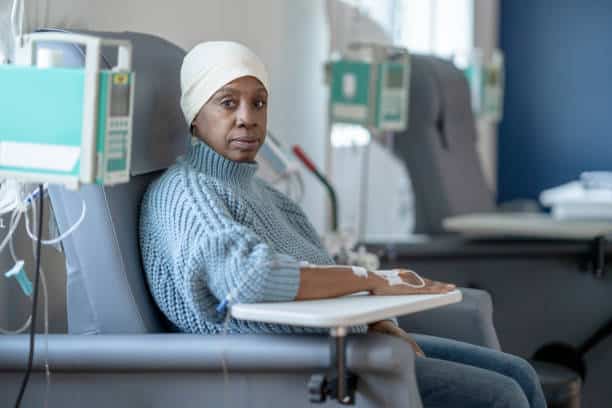What does survival look like when a healthcare system decides your life is negotiable? Watch here.
That question echoed through a powerful 45-minute panel streamed live on Facebook and LinkedIn. Titled What New Yorkers Do Best—Expose 340B Loopholes, the conversation opened the floodgates on one of the most under-discussed issues impacting patients in underserved communities. The focus was sharp and local—centered on how the 340B Program is being manipulated in New York, while the people it was meant to serve are still left to fight for their lives alone.
Panelists included New York State Assembly member Amanda Septimo, National Consumers League CEO Sally Greenberg, and breast cancer survivor and Tigerlily Foundation advocate Garrina Ross. The conversation was moderated by Ebony JJ Curry, a journalist experienced in holding healthcare systems accountable, especially around 340B transparency in Michigan. But this was about the everyday people in New York who are falling through the cracks of a system built with no safety net.
Garrina Ross didn’t mince words. She told her story without needing polish or pity. Diagnosed with breast cancer and facing treatment options that could determine her survival, she was presented with a price tag instead of a pathway. “I had to pay upwards of $30,000 a month for a specific cancer drug,” she said. There was no mention of a 340B discount. No advocacy from the hospital offering help. No indication the system designed to support her even saw her.
That moment wasn’t an outlier. It was a warning.
A new national poll conducted by Morning Consult and released by the National Consumers League revealed that the vast majority of Americans are aligned on one issue—340B must work for patients, not profits. Out of more than 10,000 adults surveyed, 78% support requirements that ensure patients directly benefit from the 340B drug discounts, lowering their out-of-pocket costs. Just as telling, 77% believe hospitals participating in the program should be legally required to pass those savings on to the people the program was designed to help. Across regions and income brackets, Americans are tired of programs being manipulated while those facing health crises continue to struggle with medical debt. The polling data also found that over half of respondents currently carry or previously carried medical debt—and many delayed necessary medical care as a result.

RELATED: HEY OREGON! BDO is PULLING THE CURTAIN ON 340B!
This wave of public sentiment reinforces what advocates like National Consumers League CEO Sally Greenberg have been sounding the alarm on for years. Greenberg stated, “Americans have said loud and clear: They want a 340B program that puts patients first, not profits.” Her remarks reflect growing national frustration with how the program has morphed into a profit engine for hospitals and contract pharmacies. A Senate report led by Sen. Bill Cassidy uncovered further abuse, including massive drug price markups at 340B hospitals, declining charity care, and a lack of financial transparency. With 340B drug purchases hitting $66.3 billion last year alone, patients and advocates alike are demanding Congress implement strict oversight, clear reinvestment benchmarks, and annual reporting requirements to restore the original mission of the program: affordable access to life-saving medications.
The 340B Drug Pricing Program was established to allow hospitals and clinics serving vulnerable populations to purchase outpatient drugs at significantly reduced prices. The idea was simple: offer hospitals a way to stretch resources and provide better care to low-income and underserved patients. For communities grappling with high rates of chronic illnesses like cancer, diabetes, and heart disease—especially in Black and Brown neighborhoods—340B was supposed to be a lifeline.
But there’s no equity without accountability. That’s the piece missing.
Across New York, there is a growing body of evidence that 340B is being leveraged not for patients but for profit. The intent behind the program has been bent into a business model. A New York Times investigation found that some hospital chains acquire struggling community hospitals not to expand care, but to qualify for the 340B discount and funnel the savings elsewhere. Meanwhile, fewer than 2% of patients actually receive their medications at 340B-discounted rates through contract pharmacies.

That’s not just a policy failure. That’s neglect.
Only 15% of 340B contract pharmacies in New York are located in low-income areas. That means the very people the program was created for are often the last to benefit from it. And nearly 85% of New York hospitals participating in 340B fall below the national average for charity care. This isn’t anecdotal—it’s systemic. The resources are not reaching the people who need them most.
Ross’s testimony pierced the panel discussion with clarity. She’s a living example of what happens when systems prioritize paperwork over people. Her voice joins countless others whose struggles with the cost of care reflect a larger truth: patients are not being prioritized. And when people must decide whether to survive or stay solvent, the system is not just inefficient—it’s inhumane.
Assemblymember Amanda Septimo addressed these structural imbalances directly. She called attention to the fact that New York’s Senate Bill S.1913 and Assembly Bill A.6222 push for more reporting from drug manufacturers, but stop short of holding hospitals and pharmacies to the same standard. That selective accountability is part of why the program’s failures continue unchecked. Reform can’t succeed when it’s only applied in one direction.
Sally Greenberg of the National Consumers League echoed that sentiment. She highlighted how the 340B program, without oversight, becomes a shell of its original purpose. Greenberg pointed out that transparency and reinvestment must be at the core of any legislative change. Otherwise, the profit-driven manipulation of 340B continues to widen the health equity gap for the very populations it was meant to serve.
The 340B program has no built-in mechanism to track where its savings go. There are no requirements for hospitals to demonstrate that the money saved is being used to expand patient care, reduce costs, or invest in community health outcomes. No reinvestment benchmarks. No measurement tools. No public record. And without those, there is no proof of impact.
RELATED: Pull Back the Curtain in 340B – There is No Other Way but to Reform

That’s the red flag.
If the 340B program functioned properly:
- Patients would carry less financial burden and avoid medical debt that often lasts years.
- Hospitals would be required to track and report how 340B funds are used to directly benefit patient care.
- There would be enforced guidelines around how much of that 340B revenue must be reinvested back into the communities the program was designed to uplift.
But right now, none of that is happening with consistency or clarity.
This is not a conversation about pointing fingers. It’s about asking better questions and demanding honest answers. Where is the money going? Who is benefiting? Why are patients like Garrina paying $30,000 a month for lifesaving medication while hospitals remain silent about the existence of a program that could help reduce those costs?
Organizations like BlackDoctor.org have taken a firm stance. We are calling on policymakers to restructure the 340B framework. Our demand is simple: prioritize patients over profits. We want reforms that enforce transparency, require reinvestment into under-resourced communities, and establish measurable accountability across every link in the 340B chain—from pharmaceutical manufacturers to the hospitals and pharmacies responsible for distributing the drugs.
Healthcare justice is not a trending topic—it’s a moral imperative. And 340B sits at the intersection of profit, policy, and pain. When hospitals and pharmacy chains benefit from programs that fail to serve the people they claim to help, it’s not a gap. It’s a breach.
This panel reminded us that reform is not just possible—it’s essential. Real lives hang in the balance. People like Garrina are forced to fight on two fronts: battling disease and surviving a system that looks the other way. That cannot continue.
New Yorkers are watching. Communities are organizing. Advocates are speaking. Lawmakers must act.
Because a program that promises equity but delivers harm is not reformable without truth, transparency, and tenacity. And our communities deserve nothing less.








